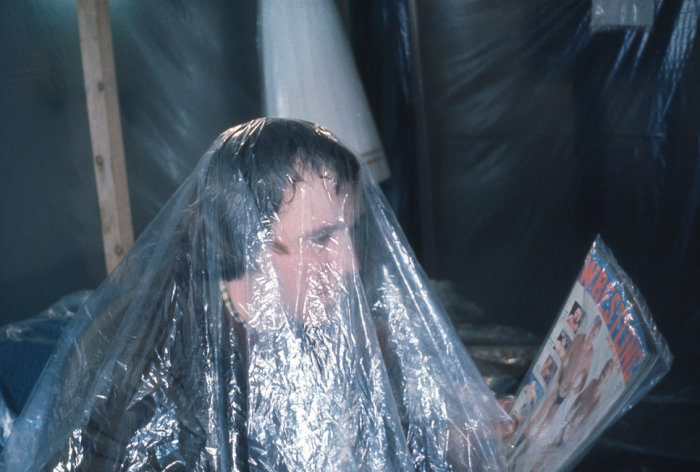The contemporary transformation of the museum into a nodal space in a global communications network discovers an unlikely precedent in the innovative practice and writings of the Canadian artist and exhibition designer Harley Parker (1915-1992). Parker is best remembered today for his extended dialogue with Marshall McLuhan, an exchange that resulted in two book projects: the 1969 edition of Counterblast, designed by Parker, and the 1968 co-authored Through the Vanishing Point, an anthology of poetry and visual art that gives sensuous expression to the interplay of literary and visual tropes which fuelled McLuhan and Parker’s discussions. Parker’s earlier experimentation with the synesthetic possibilities of typography in the eighth number of McLuhan and Edmund Carpenter’s transdisciplinary journal Explorations, brings McLuhan’s speculations on the multi-modal effects of media into evocative visibility. Perhaps the most engaging artifact of this dialogue, however, is the 1973 Picnic in Space: an improbable educational film that has served generations of students as a psychedelic gateway to McLuhan’s mind-expanding percepts.
Parker’s visionary designs for the Hall of Fossil Invertebrates at the Royal Ontario Museum (ROM) in Toronto, opened in 1967, acquire renewed relevance amidst ongoing debates about participatory pedagogy and technology-enhanced learning environments.1 Moreover, art historian Alexander Nagel’s provocative reassessment of Parker’s engagements with McLuhan’s theses on the revival of “audile-tactile” values under electronic conditions invites fresh reflection upon questions or authorship and emulation.2 This article interrogates the question of Parker’s contributions to the sensory and spatial rhetoric of McLuhan. It also explores the designer’s influence on environmental art in Canada during the heyday of McLuhanism as well as the strategies of institutional critique practiced by artists in the wake of the Museum of Modern Art’s (MoMA) 1970 exhibition, INFORMATION, which Parker likely shaped indirectly.3
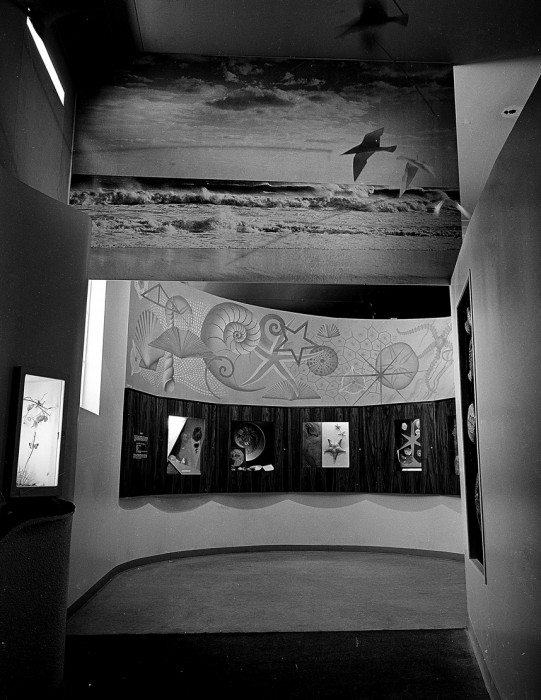
Image 1: Palaeontology Gallery, Hall of Fossil Invertebrates, April 1967. Photo: Mr. L.R. Warren, ©ROM; scan 67 EXHIB 6 #1.
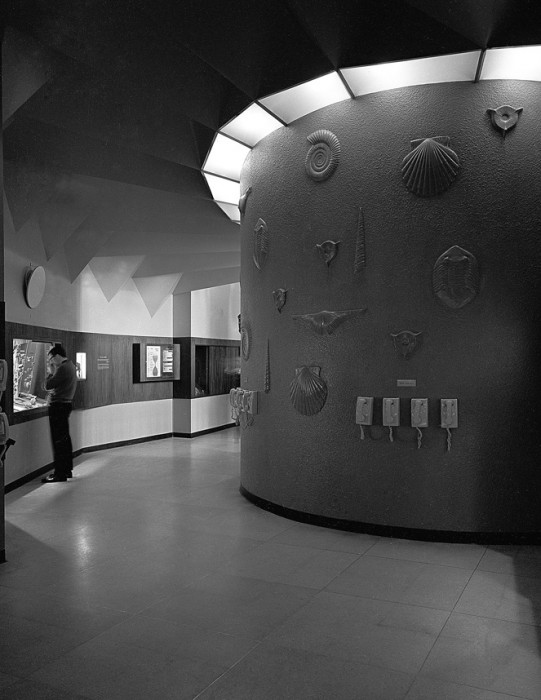
Image 2: Palaeontology Gallery, Hall of Fossil Invertebrates, April 1967. Photo: Mr. L.R. Warren, ©ROM; 67 EXHIB 6 #11.
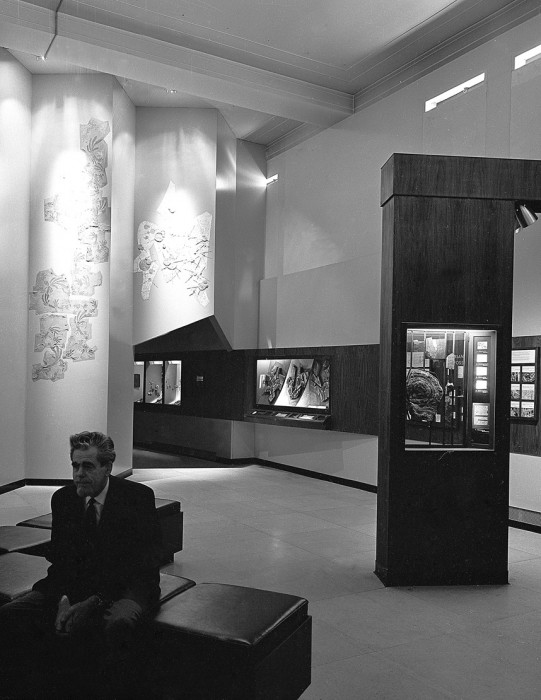
Image 3: Palaeontology Gallery, Hall of Fossil Invertebrates, April 1967. Photo: Mr. L.R. Warren, ©ROM; 67 EXHIB 7 #6.
A close reading of Nagel’s study will prompt questions about the art historian’s privileging of scholarly authority in the McLuhan-Parker exchange. Parker emerges from this re-evaluation as one of the earliest exponents of a McLuhanesque approach to the materiality of space as a medium, in the sense that Richard Cavell and Jody Berland have articulated this concept.4 Parker’s discourse on the museum as a sensuous information space simultaneously draws attention to, and contextualizes, the ascendance of “information” as the key term in McLuhan’s sixties texts.
In questioning previous representations of Parker’s designs as a “direct application” of McLuhan’s ideas – in other words, by taking seriously the irreducibly dialogical nature of Parker and McLuhan’s exchange – this article joins a growing literature devoted to the lesser known, and generally more practice-oriented, halves of prominent intellectual partnerships.5 One of Parker’s most compelling legacies is to embody the principle that practical and sensorial knowledge can be a powerful challenge to established ideas, while simultaneously instantiating the possibility that praxis can constitute a valid form of “thinking” in its own right.
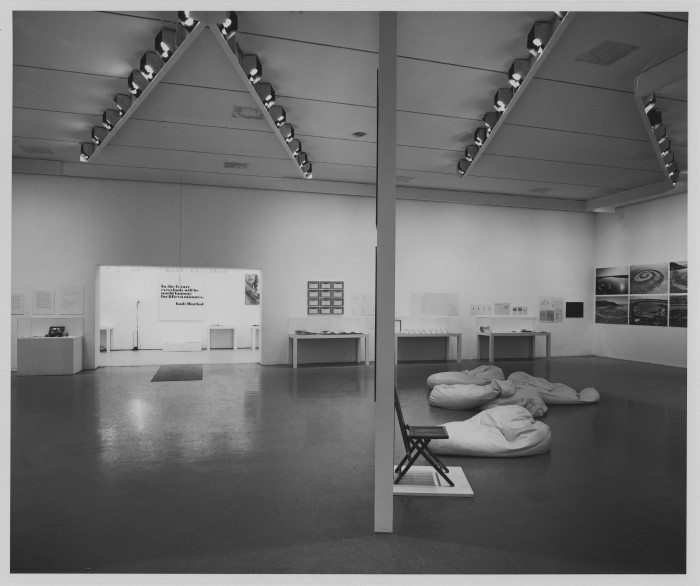
Image 4: Installation view of the exhibition “Information,” The Museum of Modern Art, New York. July 2, 1970 through September 20, 1970. Location : The Museum of Modern Art, New York, NY, U.S.A. Photo Credit : Digital Image © The Museum of Modern Art/Licensed by SCALA / Art Resource, NY. Image Reference : ART375312.
Designing without Labels
Harley Parker was born in 1915 in what was then Fort William, Ontario. A graduate of the Ontario College of Art (OCA), Parker served an apprenticeship in typographic design with Cooper and Beatty Ltd., a firm renowned for the CN logo designed by Allan R. Fleming in 1959 while serving as its Vice President and Director of Creative Services. Parker later worked as a typographic designer with the T. Eaton Co. before joining the Canadian Army as a Sergeant Instructor in camouflage in 1942. In 1945, Parker began teaching at OCA, a position he held until 1957. In the summer of 1946 he attended Josef Albers’s famed design course at Black Mountain College in North Carolina.
At some point in the early 1950s, Parker befriended McLuhan – then a controversial English professor at the University of Toronto. A 1970 profile on Parker claimed the two met at a three-person exhibition featuring paintings by the designer.6 In 1957, Parker moved from OCA to the ROM, where he was appointed Head of Design and Installations. Parker’s tenure at the museum was marked by a number of ambitious exhibitions, for which he received credit usually reserved for curatorial staff. These included Masks, The Many Faces of Man (1959) and Search and Research (1962), the latter of which was lauded by The Globe Magazine as “the most ambitious and difficult exhibition ever devised by a Canadian institution.”7 What is so striking about these exhibitions today is not so much that a designer was singled out for accolades typically reserved for the curator, but rather that contemporary reports underline Parker’s role as their designer (he did not, in fact, “curate” these exhibitions, or “displays,” as they were called, but was credited as their “designer” – even though no curator was involved).
Parker’s status as a designer of innovative exhibitions invites comparisons with the contemporaneous work of MoMA’s production manager Charles Froom, who shared credit with curator Kynaston McShine for the dematerialized environment of INFORMATION: the era-defining 1970 exhibition of Conceptual art, for which Parker’s concepts likely served as a partial inspiration. Like the “amorphous” spaces orchestrated by Froom,8 Parker’s designs were involving and sensuous. In a 1967 journal article, Parker went so far as to propose that the museum designer should take their cue from “Go Go girls and the psychedelic event.”9 But unlike the “neutralized, aestheticized framework” devised by Froom,10 Parker’s environments were conceived as an abrasive interface with the museum and its curatorial departments and functions.11
Indeed, Parker’s designs derived the greater part of their force from his explicit framing of his own labour as a museum practitioner in opposition to the scholarly standards and norms traditionally vested in the curator. Parker’s critique of the institution of the museum and of curatorial exceptionalism is most explicit in comments recorded in the transcript of an October 1967 museum seminar organized by the Museum of the City of New York, Exploration of the Ways, Means, and Values of Museum Communication with the Viewing Public, for which McLuhan and Parker were invited to engage in a free-ranging futurological thought experiment.
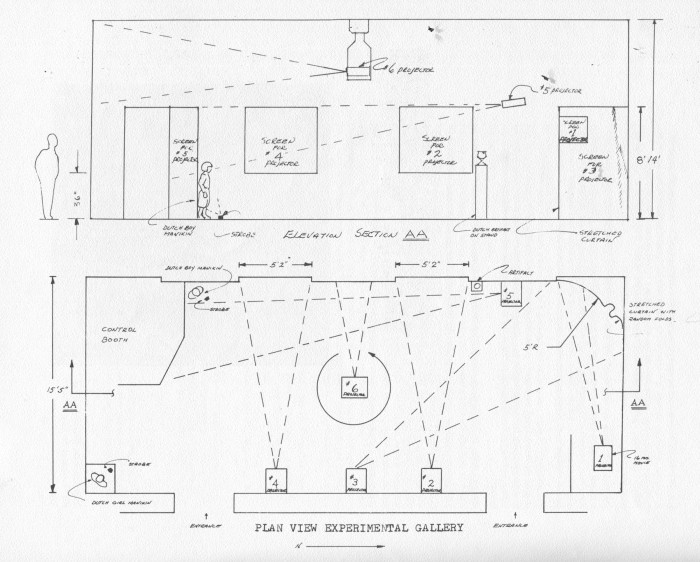
Image 5: Harley Parker, “Plan View Experimental Gallery,” in McLuhan, Marshall, Harley Parker and Jacques Barzun. Exploration of the Ways, Means, and Values of… Museum Communication with the Viewing Public (New York: The Museum of the City of New York and The New York Council on the Arts, 1969), 36.
In conjunction with the seminar, Parker improvised a temporary, multi-media installation intended to “orient” visitors to the permanent Dutch Gallery of the Museum of the City of New York through “involving” audio-visual cues that anticipated his subsequent proposal with McLuhan in Through the Vanishing Point to “redesign […] the so-called ‘light shows’ so that they cease to be merely bombardment and become probes into the environment […] in an educational sense.”12
What I have done is to juxtapose a number of Dutch slides, some showing the gallery as it exists, others with views of Holland, various paintings and artefacts. We have contrasted this with the current New York scene. I got a Tony Schwartz film with sound, called ‘My Own Yard to Play In’ which is concerned with the children in New York Streets, playing with all kinds of make-shift this and that. I know that real children’s games don’t change that much; so if you want to extrapolate the children you see on the streets of New York into New Amsterdam, I think you can do it that way. […] I hope you enjoy this as an experience, and just look upon it totally in the sense that it’s intended. Although we have tried to create some kind of unity, don’t look at it from that point of view.13
The deliberately non-linear, multi-sensuous environment devised by Parker for the seminar was both an extension of the synesthetic concerns that informed his Hall of Fossil Invertebrates but also, in its more prominent use of multiple screens and projected images, suggests connections with Parker’s as-yet-unexplored role as a design consultant to the Canadian Government for Expo ’67: a multi-screen spectacle which Janine Marchessault has evocatively characterized as projecting “the flexibility of the city in movement.”14
Parker’s trenchant critique of the ROM, as recorded in the 1967 seminar transcript, is revealing testimony of the forces that conspired to engineer his departure from the museum that same year. (Under the field “Other Information,” Parker’s ROM employee card officially records: “One year’s leave of absence granted Sept. 1st to August 31st 1968. Did not return.”) Factors contributing to the designer’s going AWOL might include the following: playing on McLuhan’s Lewisian characterizations of the artist as “the enemy,” Parker proposed that “a designer in a museum is a sort of persona non grata.”15 A 1970 profile on Parker published by the Toronto Citizen was even more explicit in its positioning of the designer as a dissonant voice: “most museum people,” Parker was quoted as saying; “including Peter Swann (director of the ROM) are oriented towards objects rather than people.”16
The next stop on Parker’s professional trajectory was McLuhan’s Centre for Communication and Technology at the University of Toronto, where he served as a research associate from 1967 to 1975. In the 1967-68 school year, Parker accompanied McLuhan – along with anthropologist Edmund Carpenter (who by that time had re-located from the University of Toronto to San Fernando Valley State College in California) – to Fordham University in New York City, where McLuhan had been appointed Albert Schweitzer Chair in the Humanities.17 Carpenter and Parker taught communications and assisted with publishing projects – projects interrupted by an unexpected operation to remove a tumor from McLuhan’s brain in November.18 Upon his return to Toronto in 1968, Parker devoted himself to the preparation of a manuscript for an ultimately unpublished book, prospectively titled The Culture Box. According to an excerpt published in the University of Toronto’s Varsity Graduate in 1972, Parker’s text set out to explore the museum as a “perception kit” for studying “the sensory orchestrations of peoples.”19
In 1973, Parker accepted the position of first Institute Professor of Communications at the Rochester Institute of Technology in Rochester, New York. He returned to Toronto in 1974 to resume his work with the Centre for Communication and Technology. In 1976 he retired to the Kootenay Mountains in British Columbia, where he pursued an active practice as a watercolourist until his death in 1992.
Anachronic Futurity
The scholarship of Alexander Nagel is central to an emergent “temporal turn” in contemporary art historiography that foregrounds the multiple temporalities of artworks and their reception activated by practices of citation, restoration and antiquarianism.20 Nagel’s groundbreaking 2010 collaboration with Christopher Wood, Anachronic Renaissance, challenges traditional models of authorship as well as the linear chronology of historicism by exploring “substitutional” modes of image making that emphasize formal continuity over material consistency as well as artifacts which “resist anchoring in time” through their appeal to non-human foundations.21 Nagel and Wood’s asynchronous approach enhances our understanding of the weird temporalities unleashed by objects propagated in devotional contexts. But despite gesturing toward the anachronic object’s prospective capacity to “fetch the future,”22 the authors remain captivated by the recursive structure of the origin stories that dominate their inquiry. This retrospective outlook equally characterizes Nagel’s subsequent solo study of the medieval modernism of McLuhan, as embodied by the eminently anachronic design of Parker’s Hall of Fossil Invertebrates.
Nagel’s interpretation of the multi-sensuous products of McLuhan’s dialogue with Parker as instantiating a specifically 1960s form of “medievalism” that operated as a strategy for “coping” with the post-industrial environment of information,23 leisure and service, constitutes a valuable addition to our knowledge about the sources of McLuhan and Parker’s audile-tactile concerns. Nagel’s account foregrounds Parker’s enrolment in a 1946 summer course at Black Mountain College taught by former Bauhaus instructor Josef Albers as a primary influence on the designer’s subsequent explorations. Nagel quotes from a notebook maintained by fellow student, Harry Seidler, now in the MoMA archives, in which Albers deployed synesthetic rhetoric suggestive of D.C. Williams’s subsequent speculations on “acoustic space,” published in McLuhan and Carpenter’s journal Explorations,24 while simultaneously hearkening to medieval models of active reading and scribal culture. Nagel argues that Parker’s multi-sensorial approach to the Hall of Fossil Invertebrates applied basic Bauhaus lessons gleaned by the ROM designer during his course with Albers, in tandem with McLuhan’s analyses of pre-typographic culture in The Gutenberg Galaxy.25 The neo-medievalism of Parker’s non-visual design strategies – which included “light controls, ozone smells, and a sea-shell-implanted ramp,” as one contemporary visitor recorded – were, Nagel persuasively argues, “intended to maximize the participation of the visitors in multi-sensorial ways, rather than replicating book-page design in two-dimensional visual displays.”26
While attending to the overlap between Bauhaus principles and the participatory aims of Parker’s synesthetic environment is instructive, it assigns a somewhat inactive role the designer that unfairly diminishes the scope of his innovations (at its most terse, Nagel’s assessment reduces Parker’s participation to a variable in a mathematical formula, where “Parker (Albers + McLuhan) = Hall of the Fossil Invertebrates”).27 Moreover, Nagel’s quest for a “medieval modern” overlooks the more futurological elements of Parker’s and McLuhan’s thought experiments; instantiated, in the case of Parker, by his visionary 1963 description of the “museum as a communication system.”28
We should not underestimate the extent to which Parker’s deep knowledge of art history and art theory contributed to articulations of “audile-tactile” perception and “acoustic space” attributed to McLuhan under the influence of D.C. Williams and Edmund Carpenter. To be sure, when reading Parker’s articles, one is immediately struck by the author’s heavy reliance on “McLuhanese.” Yet, as Parker wrote, “we trade[d] so many ideas that I never know which were his originally and which mine.”29 In other words, elements of the familiar McLuhan argot may have been a collective product. Writings by Parker suggest that, for instance, his knowledge of the Baltic German chemist and colour theorist Wilhelm Ostwald (1853-1932) – a member of the Bauhaus advisory board – was one source for McLuhan’s representations of the “sensorium” as a constantly-shifting ratio of sensory data that, when placed under environmental stress, seeks “closure.”30 Parker’s first reference to Ostwald, in his 1963 article for Curator, re-states the chemist’s view that “all sensation is one hundred per cent – a unity,”31 a dictum subsequently paraphrased by McLuhan in Understanding Media in a section introducing the cybernetic physiology of the Canadian stress researcher Hans Selye.32
Similarly, Nagel downplays Parker’s role in the development of perceptual tropes crystallized in a 1967 portrait of McLuhan against the backdrop of the Hall of Fossil Invertebrates captured by the photographer Yousuf Karsh. Seated at an appropriately imposing and professorial desk, McLuhan is strategically positioned between the plaster scallops and curving bank of telephones of Parker’s audile-tactile exhibition space – an open book displayed before the scholar suggestively revealing a mosaic from the church of Hagia Sophia.

Image 6: Yousuf Karsh, Marshall McLuhan at the Royal Ontario Museum, 1967. © Yousuf Karsh. Courtesy karsh.org.
Nagel proposes an inspired reading of the startling conjuncture of scallop and telephone in Karsh’s photograph as “a sign of the return to medieval space-time and the modality of the audible.”33 While a brilliant exposition of McLuhan’s ideas – one that grounds the dematerialized claims of theory in the tangible features of Parker’s space, Nagel’s analysis overlooks key details that speak to the two-way nature of the designer’s exchange with McLuhan. For instance, Nagel emphasizes McLuhan’s argument in The Gutenberg Galaxy that, “the pre-typographic era was a necessary counterpart to the electronic revolution” as formative of Parker’s environment at the expense of the designer’s own practical experience as a typographer.34 Parker acquired that experience in the commercial milieu of Cooper and Beatty Ltd. and at Eaton’s, and, subsequently, as the designer of the experimental Explorations Number 8 – later republished as the stand-alone 1967 volume, Verbi-Voco-Visual Explorations.35
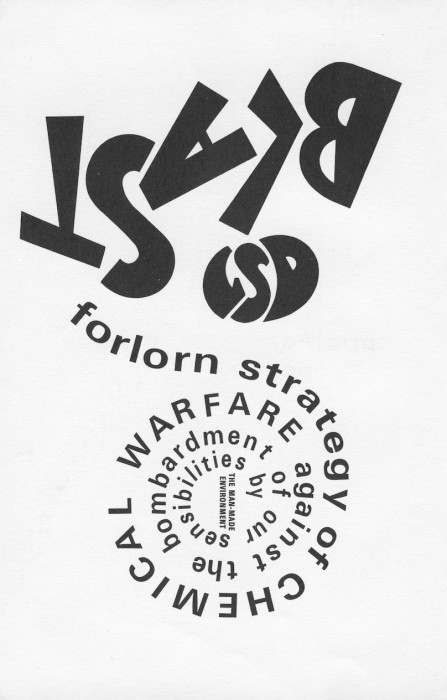
Image 7: Marshall McLuhan (author) and Harley Parker (designer), “Blast LSD,” in Marshall McLuhan, Counterblast (Toronto: McClelland and Stewart, 1969), 8. Copyright the Estates of Harley Parker and Marshall McLuhan.
Like the patterns generated by a Chladni plate, Parker’s hyperaesthetic designs for Counterblast visualize what McLuhan, quoting T.S. Eliot, referred to as the “auditory imagination.”36 Typographic distortions amplify McLuhan’s earlier experimentation with a Lewisian “headline” style in the 1954 edition of Counterblast into sinuous evocations of sound waves.37 Where Nagel portrays the designer as merely applying the fully formed concepts of the scholar, Parker and McLuhan’s common perceptual language can be seen to have emerged, rather, out of a shared field of practical and theoretical experimentation and dialogue.
Rather than seeking a precedent for the “pre-typographic” space of Parker’s Hall of Fossil Invertebrates in the mosaics of Hagia Sophia suggested by the open book of Karsh’s photograph, we might look instead to the more proximal prototype of a curving mural designed by Parker for the 1962 exhibition Search and Research.
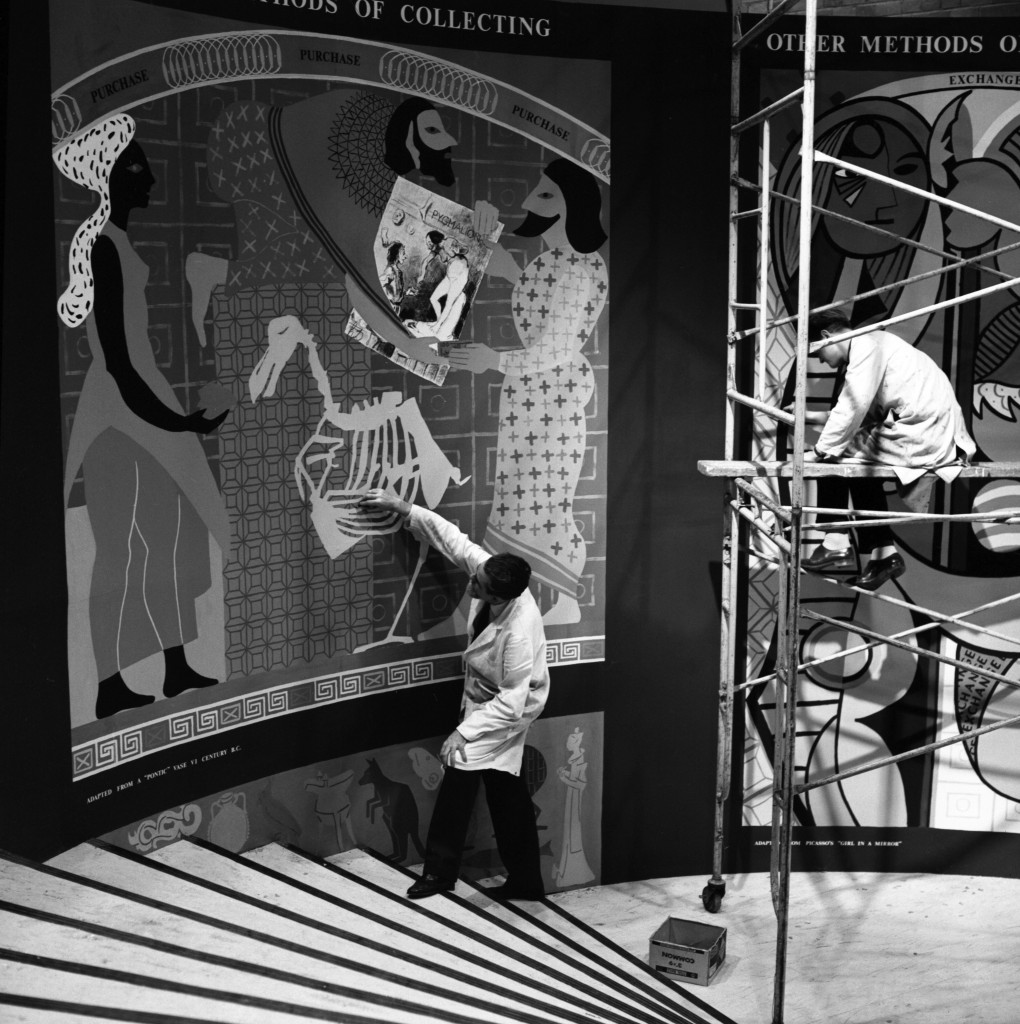
Chief of design and display for the Royal Ontario Museum, Harley Parker, works on one of the murals he has designed for the museum’s special 50th anniversary exhibition, Search and Research, March 13, 1962. Artist Girts Tiltins is at right. Photo by Erik Schack (Erik Christensen} / The Globe and Mail. Originally published March 31, 1962, The Globe Magazine, Front cover.
The mural satirized the activities of ROM research staff in a witty montage of historical styles juxtaposing Greek vase painting with Daumier and Picasso and exploiting the unique spatial possibilities of a spiral staircase in a fashion anticipating the “sound-funneling shape” of the Hall of Fossil Invertebrates.38 I want to argue that Parker’s work as a designer – his experience solving practical problems, particularly problems involved in communicating complex spatial ideas through simplified forms and modest materials – persists as a largely unacknowledged influence on his own, and McLuhan’s, spatial and perceptual vocabulary. For instance, “the igloo [as] an excellent example of an auditory space” was brought into representation by the biomorphic contours of Parker’s design proposal for a Canadian Eastern Sub-arctic gallery.39
Although Nagel hints that the conjunction of seashell and telephone bank in Parker’s Hall of Fossil Invertebrates announces that “the scribal mode persists and is now joining forces with the electronic culture that resonates and radiates on all sides,” his gloss on Parker’s environment minimizes the extent to which the designer envisioned the contemporary museum as a form of “data presentation” commensurate with the fluid dynamics of an “electronic revolution” then only recently underway.40 Although Parker was certainly not unsympathetic to the types of medieval tropes explored by Nagel (for instance, Parker’s 1967 article for Curator likened his Hall of Fossil Invertebrates to the resonant “space of the medieval cathedral”),41 his primary concern was with the “need [for] a new ordering” in an information environment.42 “Data are not exactly contained in structure,” Parker presciently observed; “They are the structure, and all the data in a structure are in a constant state of interplay.”43 Parker’s fixation on “data” suggests that information superseded space as the key word in McLuhanesque discourse of the sixties. It is Parker’s futurological concern with the dynamic spaces and new sensory modalities made available by information technologies that clears a path for the conceptual and environmental projects of artists and curators influenced by his writings in the later half of that decade through the beginning of the next. If Nagel persuasively argues that Parker’s designs paralleled McLuhan’s creative adaptation of medieval models of “multileveled meaning” to cope with the effects of a new age of information overload, Parker’s “paratactic” museum spaces were every bit a product of Einstein and other non-Euclidean spatial models as well as electronic technologies that significantly trouble the medieval space-time which is the tacit archetype of Nagel’s cyclical articulation of anachronic temporality.44 Rather than a “simple return to the medieval integration of the senses,” Parker’s designs staged what he aptly termed in an interview with New York Times Reporter John M. Lee, “a clash of spaces [and] objects from different cultural environments” animated by new technologies.45
A “Newseum” for the Information Age
Notwithstanding the resistance with which his installations and theories were met by curators and fellow museum professionals, Parker’s participatory, multi-sensorial environments set a powerful precedent for contemporary Canadian artists in the mid-1960s, many of whom were then steeped in McLuhan’s writings – and one that was closer to hand than the contemporaneous “happenings” of California or New York-based installation and performance artists such as Allan Kaprow. In this respect, Parker’s designs would have contributed to North American artists’ awakening to McLuhan’s speculations documented by Kenneth Allan.46 Perhaps the most literal application of Parker’s design theories was made by the Toronto art-and-music collective Intersystems, which included Parker’s son, the poet Blake Parker. However, my overview of Parker’s influence will, perhaps counter-intuitively, focus on Vancouver as well as the watershed 1970 MoMA exhibition, INFORMATION.
There are clear parallels between Parker’s theories and the pedagogical experiments of the Vancouver-based group Intermedia, founded in 1967. Intermedia’s multi-modal events exemplify Scott Watson’s portrait of the sixties Vancouver scene as a performative milieu characterized by “acts of documentation and witnessing.”47 Nancy Shaw (2011) noted that the group’s mandate encompassed an ambitious range of educational initiatives inspired by the radical pedagogy of McLuhan,48 including an experimental kindergarten and a free high school. Recalling the educational aims of Parker’s synesthetic museum, “Intermedia’s educational and artistic components,” wrote Shaw, “were countercultural projects aimed at expanding the perceptions of teachers and students alike through techniques derived from multidisciplinary art-making.”49 In a 2005 interview with former Intermedia board member Victor Doray, Doray’s wife, the artist Audrey Capel Doray, draws attention to Parker’s influence on the former’s thinking during the years of the organization’s activity.50 Parker’s graphic designs for Counterblast, Explorations, and Through the Vanishing Point advanced stimulating models of McLuhanesque design that would have been ready to hand in Vancouver. But his exhibition spaces also received wide press coverage in Canada, and would have been familiar even to those unable to visit the Royal Ontario Museum in person. Nor should McLuhan’s presence in Vancouver as part of the 1964 and 1965 iterations of UBC’s annual Festival of the Contemporary Arts – the latter of which included a multi-media “happening” inspired by his sensory musings, titled The Medium is the Message – be discounted as possible conduits for the dissemination of Parker’s multi-modal environments.51
A 1968 artscanada feature authored by Doray, “The future of education in the arts,” disseminated the utopian pedagogy of Intermedia to readers across Canada. Like Parker, Doray attributed emerging challenges to the traditional academy to a gathering “flood of information.”52 Likewise recalling Parker, Doray forecast an end to the divisions enforced by mechanical technologies – not only divisions between the disciplines, but between “Knowledge and Life.”53 He predicted a coming “Life knowledgeopolis” of modular technical training programs capable of grafting themselves onto existing institutions as required.54 Doray schematized this visionary proposal in an accompanying illustration of a “mobile information van” – represented as a portable data centre echoing Parker’s earlier proposal for a “newseum”:
I want to build what I call a ‘newseum,’ which consists of a building outside the museum proper, but which draws on the artefacts and materials of the museum for its shows. The idea of a newseum is that it is concerned with news, any news in the world which is of great moment, whether it occurs in science or archaeological discovery or what have you, or whether it occurs on the political scene.55
Parker’s newseum was an extension of Ezra Pound’s dictum – frequently reiterated by McLuhan – that, “Literature is news that stays news,”56 which simultaneously responded to the Toronto media thinker’s discourse on information as the primary commodity of post-industrial society and his representations of the “satellite” as the chief symbol of the “global village” brought into visibility by increasingly unlimited information flows.57 In Parker’s creative translation of these ideas, the newseum emerges as an experimental satellite of the conventional museum space, which, like the earth itself in McLuhan’s gloss on Sputnik, is thereby transformed into an art form: a creative communication centre that clears a path for conceptual artists’ later reworking of the gallery space into an arena for the transmission and reception of data.
A more critical and transformative approach to Parker’s ideas was staged by IAIN BAXTER& – or Iain Baxter, as he was then known – in 1966: one year prior to the formation of Intermedia, and shortly before the creation of the conceptual enterprise, N.E. Thing Co. Ltd. (co-administered with Ingrid Baxter after its legal incorporation in 1969).58 Bagged Place was an installation at the UBC Fine Arts Gallery, which transformed the “white cube” of the gallery space into a generic residential unit, which Scott Watson has likened to the urban condo spaces that were making their debut in Vancouver at precisely the same moment.59
The complete contents of Baxter’s installation – down to a turd deposited in the toilet by the artist’s son – were bagged in clear plastic, thereby drawing attention to the ubiquitous disposability of products in a consumer society. While clearly responding to McLuhan’s vision of the “environment as mediated” – as Richard Cavell has proposed – it is also likely that Parker’s sensorial spaces were an indirect influence on Baxter’s intervention via the artist’s frequent conversations with Doray.60 A 1967 draft report penned by Baxter and Doray with the painter Jack Shadbolt in the immediate aftermath of Intermedia’s founding further illuminates the influential nature of McLuhanesque pedagogy in the milieu of mid-1960s Vancouver. The document calls for the foundation of an unrealized “centre for interdisciplinary, or interdepartmental, studies,” CIRCA, or Centre for Intermedia Research and Communication Analysis. “Communication,” wrote the artists; “Any process of transmitting information may be conceived as communication. All branches of the fine arts can be thus studied, together with the popular arts, folk art, non-art, and even anti-art.”61 In the same 2005 interview quoted above, Doray singled out his telephone dialogues with Baxter as a fixture of the Intermedia period: “I was being phoned all the time by Baxter – Iain Baxter,” he states. To which the interviewer responds: “Why was he calling you?.” “To ask me of ideas about McLuhan and all this stuff.” (At this point, the artist’s wife, Audrey Capel-Doray, interjects: “I kept saying: ‘get off the phone, I haven’t seen you all day!’”).62
If Parker’s synesthetic articulation of space was an indirect influence on Baxter’s immersive environment, the Vancouver-based artist took the designer’s explorations of space as a medium in bold new directions. Through his innovative, and influential work as a teacher at UBC, Baxter experimented with McLuhan’s notion of the “classroom without walls” through non-verbal teaching techniques.63 He would revisit this topos during his subsequent tenure at Simon Fraser University in the performance 24-Hour Class (1967),64 which condensed a full year of one-hour classes into an intensive, all-day seminar that exploded the four walls of the conventional classroom to encompass the entire city of Vancouver as a living laboratory. This intervention within institutional pedagogies operationalized the Parker-like principles harnessed by Doray’s parallel proposal for a mobile information van. 24-Hour Class seized upon the educational possibilities of Bagged Place to embrace a newly expanded notion of space that looked beyond the enclosed sensorial modules of Parker and Intermedia to the environment at large as a platform for urban exploration.
The N.E. Thing Co.’s subsequent 1969 installation at the National Gallery of Canada – N.E. Thing Co. Ltd. Environment – resonated with Parker’s and Doray’s earlier conceptualizations of the newseum and mobile information van in its transformation of the Ottawa museum space, which then occupied a typical office structure, the Lorne Building, into a temporary corporate satellite showcasing the knowledge work performed by Company personnel.
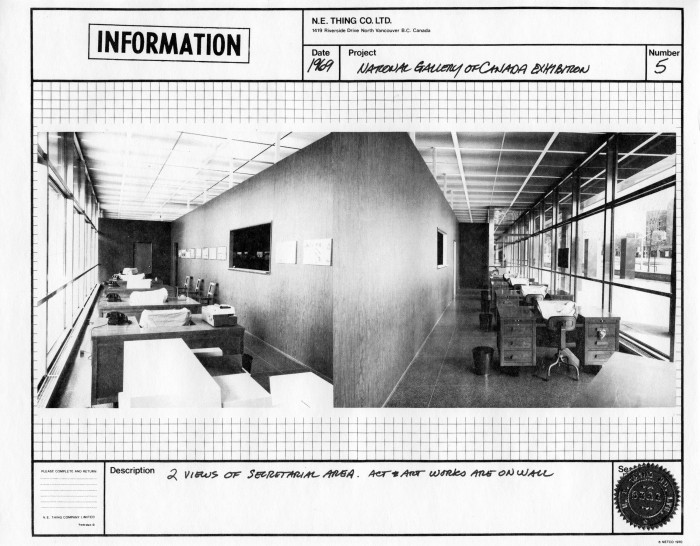
Image 11: N.E. Thing Co. Ltd., “2 Views of Secretarial Area,” in N.E. Thing Co. Ltd., N.E. Thing Co. Ltd., Vol. 1 (Vancouver: N.E. Thing Co. Ltd., 1978), n.p.
The installation can be read as a satirical materialization of Parker’s vision of the museum of the future as an information centre that set the stage for the subsequent demands of protestors, such as The Art Strike Against Racism, War, and Repression, to transform museums “into venues for ‘information activities.’”65 NETCO’s National Gallery Environment also likely shaped McShine’s INFORMATION show at the MoMA, staged the following year as an exercise in repressive tolerance responding to those very protests. The MoMA exhibition included a live feed of N.E. Thing Co. data, transmitted by Iain Baxter from the Company’s headquarters in North Vancouver.66 In exposing the newly prominent place of information and services within the museum, NETCO’s remote participation recalled Parker’s earlier challenge to curatorial authority, and set the stage for the more overtly antagonistic, and better-known, practices of institutional critique developed by Hans Haacke and, later, by Michael Asher, in the wake of INFORMATION.
But Parker’s influence, as art historian Ken Allan has postulated in his insightful study of INFORMATION,67 was probably felt more directly by MoMA administrators – notably by McShine’s superior, Director John Hightower. Allan notes that Hightower was a participant in the 1967 museum seminar at which Parker laid out his vision of the newseum of the information age. In fact, as then Executive Director of the New York State Council of the Arts, Hightower was instrumental in funding the seminar – a circumstance suggesting more than a passing interest in Parker’s dialogue with McLuhan.68 Parker’s visionary comments at the seminar, which was attended by many of New York’s leading museum administrators and curators, cannot be underestimated as a stimulus for the “dematerialized,” interactive, and informatic environments engineered at major galleries in the subsequent decade.69
McShine’s incorporation of press photography into the design of INFORMATION has led some commentators to liken the exhibition’s “report” on contemporary art to journalism.70 This interpretation suggests parallels with Parker’s earlier proposal for a newseum that would “put on shows of those items which are in the news.”71 Parker’s scheme to locate the newseum “outside the museum proper” likewise shared with the documentary practices showcased by INFORMATION the ambition of “set[ing] up a dialogue between the gallery and the world beyond the walls of the museum.”72 Furthermore, Parker’s invocation of the museum as an extension of “show business” anticipated the “highly visible corporate presence at Information” noted by Staniszewski.73 That presence was epitomized by the Telex and telecopier machines loaned by ITT World Communications and Xerox Corporation to facilitate the remote participation of the N.E. Thing Co., whose exploration of the multi-modal capabilities of facsimile transmission echoed Parker’s earlier discourse on the “technological possibilities of reproducing artifacts” in the 1967 museum seminar.74
Whether or not McShine was directly aware of Parker’s innovations (although this seems probable given the extensive media coverage of McLuhan’s Fordham sojourn, during which Parker would have been frequently at the media thinker’s side), the eye-catching design sensibility crafted in dialogue with Parker to brand his media insights found its way into INFORMATION in the form of a novelty deck of playing cards originally mailed to subscribers of McLuhan’s DEW-Line Newsletter.75 The exhibition checklist also includes several wall texts authored by McLuhan – apparently, and appropriately, catalogued as works of art.76
Allan notes the seeming paradox implied by the “non-object qualities” that McShine hoped to impart via the obdurate materiality of the furniture he requested from the Director of MoMA’s Department of Architecture and Design, Arthur Drexler.77 However, it is possible to read into McShine’s counterintuitive desire to communicate dematerialization via the corporeal connotations of Gatti, Paolini and Teodoro’s amorphous 1968 “Sacco” chair a sensory conception of information commensurate with Parker’s discourse on the synaestehtic properties of the new data environment in his articles for Curator. Moreover, McShine’s preference that, “none of these objects would be labeled,” recalls Parker’s earlier vision of “a gallery with no labels at all.”78 Taken together, these correspondences suggest that Parker’s futurological descriptions of the “museum as a communication system” likely served as a model for INFORMATION, albeit indirectly.
Conclusion
The legacies of Parker’s innovative museum practice and contributions to design theory cut across a broad swath of contemporary art and museum discourse and praxis, and still resonate strongly today in the so-called “sensory turn.”79 As I have begun to outline here, Parker’s articles of the early 1960s, his Hall of Fossil Invertebrates, his challenge to the values and structures of the traditional museum articulated at the 1967 seminar in New York, and, of course, his textual collaborations with McLuhan, all point in different ways to leading developments in art and museum practice of the following decade, many of which have only grown in importance with intervening years. These included: institutional critique, interactive design, a discourse on the aesthetics of “participation,” and articulations of “space” as a material and virtual medium. Above all, Parker’s spaces are enduring testimony to the busy traffic between contemporary art and media theory that developed in English Canada during the sixties, a period when media theory was art theory for many younger artists.
See Nicolas Bourriaud, Relational Aesthetics, trans. Simon Pleasance and Fronza Woods with Mathieu Copeland (Dijon, Fr.: Les Presses de reel, 2002); Claire Bishop, Artificial Hells: Participatory Art and the Politics of Spectatorship (London: Verso, 2012); Adam Lauder, “Harley Parker: Design for ‘A New Ordering,’” Hunter and Cook, no. 9 (2011): 52-57. ↩
Alexander Nagel, Medieval Modern: Art Out of Time (London: Thames & Hudson, 2012). ↩
See Ken Allan, “Understanding Information,” in Conceptual Theory, Myth, and Practice, ed. Michael Corris, 144-68 (Cambridge: Cambridge University Press, 2004), 165n35. ↩
See Richard Cavell, McLuhan in Space: A Cultural Geography (Toronto: University of Toronto, 2002); Jody Berland, North of Empire: Essays on the Cultural Technologies of Space (Durham, NC: Duke University Press, 2009). ↩
Nagel, Medieval Modern, 161. See, for instance, Gary Genosko, Remodelling Communication: From WWII to the WWW (Toronto: University of Toronto Press, 2012). ↩
“Fronting for McLuhan,” Toronto Citizen, September 19, 1970, p. unavailable. ↩
Pearl McCarthy, “For Fifty Fruitful Years,” The Globe and Mail Magazine, March 31, 1962, 7. ↩
Mary Anne Staniszewski, The Power of Display: A History of Exhibition; Installations at the Museum of Modern Art (Cambridge, MA: MIT Press, 1998), 270. ↩
Harley Parker, “New Hall of Fossil Invertebrates, Royal Ontario Museum,” Curator 10, no. 4 (1967): 296. ↩
Staniszewski, The Power of Display, 286. ↩
“I believe that creativity occurs only at the point of abrasion.” Parker quoted in Marshall McLuhan, Harley Parker and Jacques Barzun, Exploration of the Ways, Means, and Values of… Museum Communication with the Viewing Public (New York: The Museum of the City of New York and The New York Council on the Arts, 1969), 49. ↩
Marshall McLuhan and Harley Parker, Through the Vanishing Point: Space in Poetry and Painting (New York: Harper & Row, 1968), 253. ↩
Parker quoted in McLuhan, Parker and Barzun, Exploration of the Ways, 38. ↩
Janine Marchessault, “Multi-Screens and Future Cinema: The Labyrinth Project at Expo 67,” in Fluid Screens, Expanded Cinema, ed. Janine Marchessault and Susan Lord, 29-51 (Toronto: University of Toronto Press, 2007), 31. ↩
Parker quoted in McLuhan, Parker and Barzun, Exploration of the Ways, 52. ↩
“Fronting for McLuhan,” p. unavailable. ↩
See “Deal for McLuhan at Fordham Held up by N.Y. Attorney-General,” Globe and Mail, September 7, 1967, p. unavailable; John M. Lee, “McLuhan’s Views Reshape Museum,” New York Times, February 26, 1967, 32. ↩
Arthur Cole, “McLuhan: Out for Christmas,” Toronto Telegram, December 8, 1967, p. unavailable. ↩
Harley Parker, “The Museum as a Perception Kit,” Varsity Graduate (January 1972): 54. ↩
See also Georges Didi-Huberman, L’image survivante: histoire de l’art et temps de fantômes selon Aby Warburg (Paris: Éditions de Minuit, 2002); Philippe-Alain Michaud, Aby Warburg and the Image in Motion, trans. Sophie Hawkes (New York: Zone Books, 2004); Keith Moxey, Visual Time: The Image in History (Durham, NC: Duke University Press, 2013). ↩
Alexander Nagel and Christopher S. Wood, Anachronic Renaissance (New York: Zone Books, 2010), 16, 7. ↩
Nagel and Wood, Anachronic Renaissance, 18. ↩
Nagel, Medieval Modern, 155; Robert Babe, “McLuhan and the Electronic Archives,” Old Messengers, New Media: The Legacy of Innis and McLuhan, 2007, http://www.collectionscanada.gc.ca/innis-mcluhan/030003-4010-e.html. ↩
See D.C. Williams, “Acoustic Space,” Explorations, no. 4 (1955): 15–20. ↩
Marshall McLuhan, The Gutenberg Galaxy: The Making of Typographic Man. Toronto: University of Toronto Press, 1962. ↩
Mottram quoted in Nagel, Medieval Modern, 163; Nagel, Medieval Modern, 162. ↩
Nagel, Medieval Modern, 163. ↩
See Harley Parker, “The Museum as a Communication System,” Curator 6, no. 4 (1963): 350-60. ↩
“Fronting for McLuhan,” p. unavailable. ↩
See Philip Ball and Mario Ruben, “Color Theory in Science and Art: Ostwald and the Bauhaus,” Angewandte Chemie 43, no. 37 (2004): 4846; Marshall McLuhan, Understanding Media: The Extensions of Man (Toronto: McGraw-Hill, 1964), 44. ↩
Parker, “The Museum as a Communication System,” 353. ↩
“It is with the senses as it is with color. Sensation is always 100 per cent, and a color is always 100 per cent color. But the ration among the components in the sensation or the color can differ infinitely.” McLuhan, Understanding Media 44. See also Parker’s discussion of Ostwald in the museum seminar transcript. Parker quoted in McLuhan, Parker and Barzun, Exploration of the Ways, 10. ↩
Nagel, Medieval Modern, 167. ↩
McLuhan, The Gutenberg Galaxy, 156. ↩
Marshall, McLuhan et al., Verbi-Voco-Visual Explorations (New York: Something Else Press, 1967). ↩
Marshall McLuhan with Wilfred Watson, From Cliché to Archetype (New York: Viking Press, 1970), 63. ↩
Marshall McLuhan, Counterblast (Toronto: s.n., 1954). ↩
Nagel, Medieval Modern, 167. ↩
McLuhan quoted in McLuhan, Parker and Barzun, Exploration of the Ways, 5. ↩
Parker, “The Museum as a Communication System,” 354, 351. ↩
Parker, “New Hall of Fossil Invertebrates,” 285. ↩
Parker, “The Museum as a Communication System,” 355. ↩
Parker, “The Museum as a Communication System,” 355, emphasis in the original. ↩
Parker, “The Museum as a Communication System,” 355, 359. ↩
Parker quoted in Lee, “McLuhan’s Views Reshape Museum,” 32. ↩
See Kenneth R. Allan, “Marshall McLuhan and the Counterenvironment: ‘The Medium is the Massage,” Art Journal 73, no. 4 (2014): 22-45. ↩
Scott Watson, “Urban Renewal: Ghost Traps, Collage, Condos, and Squats – Vancouver Art in the Sixties,” in Intertidal: Vancouver Art in the Sixties, eds. Dieter Roelstraete and Scott Watson, 31-48 (Antwerpen: M HKA; Vancouver: Morris and Helen Belkin Gallery, 2005), 34. ↩
See also Janine Marchessault, Marshall McLuhan: Cosmic Media (London: Sage, 2005), 105; Janine Marchessault, “McLuhan’s Pedagogical Art,” Flusser Studies 06, 2008, http://www.flusserstudies.net/pag/06/marchessault-pedagogical.pdf; Marshall McLuhan, “Our New Electronic Culture: The Role of Mass Communications in Meeting Today’s Problems,” NAEB Journal (October 1958): 19-20, 24-26; Marshall McLuhan, “Environment as Programmed Happening,” in Knowledge and the Future of Man: An International Symposium, ed. Walter J. Ong, 113-24 (New York: Holt, Rinehart and Winston, 1968). ↩
Nancy Shaw, “Expanded Consciousness and Company Types: Collaboration Since Intermedia and the N.E. Thing Company,” in Vancouver Anthology, 2nd ed., Stan Douglas, 91-109 (Vancouver: Talonbooks; Or Gallery, 2011), 95. ↩
Victor Doray and Audrey Capel-Doray, “Audrey Capel-Doray and Victor Doray,” Vancouver Art in the Sixties, 2005, http://intermedia.vancouverartinthesixties.com/ voices/014. ↩
See Halina Tomaszewska, “Borderlines of Poetry and Art: Vancouver, American Modernism, and the Formation of the West Coast Avant-Garde, 1961-69,” Diss., University of British Columbia, 2007, 118-32. ↩
Victor Doray, “The Future of Education in the Arts,” artscanada 25, no. 4 (1968): 31. Doray’s and Parker’s comments on the transformative effects of information on traditional models of learning echo McLuhan’s diagnosis of the disruptive impact of electric media on education in Understanding Media as a “crisis”: “Our new concern with education follows upon the changeover to an interrelation in knowledge, where before the separate subjects of the curriculum had stood apart from each other. Departmental sovereignties have melted away as rapidly as national sovereignties under conditions of electric speed.” McLuhan, Understanding Media, 35–36. ↩
Doray, “The Future of Education in the Arts,” 32. ↩
Doray, “The Future of Education in the Arts,” 33. ↩
Parker quoted in McLuhan, Parker and Barzun, Exploration of the Ways, 33. ↩
McLuhan quoted in McLuhan, Parker and Barzun, Exploration of the Ways, 53. ↩
McLuhan, The Gutenberg Galaxy, 21. “We live in an economic world in which information itself has become the main commodity.” McLuhan quoted in Marchessault, Marshall McLuhan, 220. ↩
In 2005, the artist legally changed his name to IAIN BAXTER&. ↩
Watson, “Urban Renewal,” 39. ↩
Cavell, McLuhan in Space, 183. ↩
Jack Shadbolt, Victor Doray and Iain Baxter, “Intermedia,” 1967, box 7, file 2, Iain Baxter& Fonds, E.P. Taylor Research Library and Archives, Art Gallery of Ontario, Toronto. ↩
Doray and Capel-Doray, “Audrey Capel-Doray and Victor Doray.” ↩
Marshall McLuhan, “Classroom without Walls,” Explorations, 7 (1957): 22-26. ↩
Iain Baxter, “Iain Baxter,” May 1, 1967, box 7, file 16, Iain Baxter& Fonds, E.P. Taylor Research Library and Archives, Toronto. ↩
Eve Meltzer, “The Dream of the Information World,” Oxford Art Journal 29, 1 (2006): 127. ↩
Iain Baxter to Kynaston McShine, May 1, 1970, Kynaston McShine Information Exhibition Research, IV.59, MoMA Archives, New York. ↩
Allan, “Understanding Information,” 165n35. ↩
See McLuhan, Parker and Barzun, Exploration of the Ways, 71. ↩
See, for instance, Jack Burnham and Robert Jakob, Software: Information Technology: Its New Meaning for Art (New York: The Jewish Museum, 1970). ↩
Kynaston McShine, ed., INFORMATION (New York: Museum of Modern Art, 1970), 2; see also Julia Bryan-Wilson, Art Workers: Radical Practice in the Vietnam Era (Berkeley, CA: University of California Press, 2009), 189; Hilton Kramer, “Miracles, ‘Information,’ ‘Recommended Reading,’” New York Times, July 12, 1970, 87. ↩
Parker quoted in McLuhan, Parker and Barzun, Exploration of the Ways, 33. ↩
Staniszewski, The Power of Display, 281. ↩
Parker quoted in McLuhan, Parker and Barzun, Exploration of the Ways, 43; Staniszewski, The Power of Display, 282. ↩
Parker quoted in McLuhan, Parker and Barzun, Exploration of the Ways, 12. ↩
See Allan, “Understanding Information,” 152. ↩
See Allan, “Understanding Information,” 152. ↩
McShine quoted in Allan, “Understanding Information,” 148. ↩
Allan, “Understanding Information,” 149; Parker quoted in McLuhan, Parker and Barzun, Exploration of the Ways, 14. ↩
Jim Drobnick and Jennifer Fisher, “Introduction: Sensory Aesthetics,” Senses & Society 7, no. 2 (2012): 133. ↩
This research was supported by the Social Sciences and Humanities Research Council of Canada.
Article: Creative Commons Attribution-NoDerivs 3.0 Unported License.
Image: We Built Excitement by Jennifer Marman and Daniel Borins. Used with permission.





